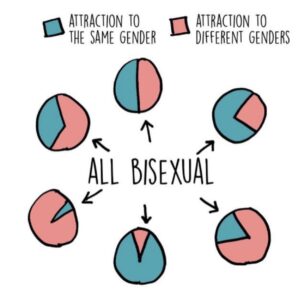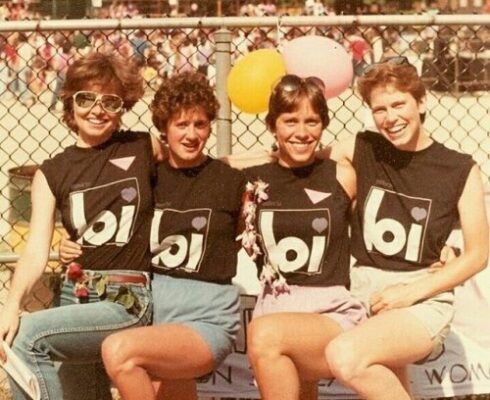Today marks national Bi Visibility Day, which has been celebrated on September 23rd since 1999. As an LGBTQ+ organisation it’s important that we mark this day, and raise the profile of issues affecting bisexual people in our community.
As an out bisexual, I am often subjected to biphobic stereotypes about what it means to be bisexual. Whether it’s having your sexuality dismissed as a phase, being told you’re greedy, or that you can’t make up your mind. And if you’re a bisexual woman like me, having to deal with straight men fetishising your sexuality and the hypersexual stereotype of bisexual women, where we’re seen as more sexual, promiscuous and greedy.

But one of the most difficult things about being a bisexual is that often these comments come from people within our own community. Despite the fact that bisexuals make up more than 50% of the LGBTQ+ community, we are often ostracised and erased by the LG community that we should feel safe and at home within.
This lack of acceptance seems to come from the belief that bisexuals don’t struggle the same as gay and lesbian people. Bisexual people are seen to be betraying the LGBTQ+ community when dating someone of the opposite sex, and to be benefitting from straight privilege, or ‘passing’ privilege.
But whilst it’s easier to exist in public as a couple when dating someone of the opposite sex, internally it can feel far from easy. The pain of having your identity erased or assumed based on the (presumed) gender of your current partner causes bisexual people a lot of inner turmoil. If we enter into a long-term monogamous relationship with someone our bisexuality is often forgotten about unless we make it visible. No matter what relationship we’re in, our sexuality is often incorrectly assumed – typically we’re seen as either straight or gay.
It’s frustrating that people believe that bisexuals are only half as oppressed as others in the LGBTQ+ community. Numerous studies have shown that bisexual people face higher rates of mental health difficulties than lesbian and gay folks. Bisexuals are more likely to experience depression and anxiety, and rates of self harm and suicide are also higher. Bisexual women also face a disproportionate risk of rape and domestic violence, as a study in 2010 found 46% of bisexual women had been raped, compared to 13% of lesbian women, and 17% of straight women; and on top of that they are less likely to be able to find specialist support and resources. And if you’re bisexual and trans or non-binary, or a person of colour – these oppressions will be elevated even further, and the support available is even more difficult to access.
In our own research on LBQ women’s health for the Health and Inclusion Project, we found that bisexuals were more likely to experience a lower standard of general health than lesbians, and more likely to have a chronic health condition. However, bisexual respondents were more than twice as likely to not be out about their sexual orientation to their GP (32%), and as a result, those who are not out were more likely to suffer from poor health. Similarly to national research, we found bisexual and queer respondents reported much higher levels of poor mental health, and suicide rates were more than three times higher for bisexual respondents (14%) when compared to lesbian respondents (4%).
This elevated rate of mental and physical health difficulties has been accredited to ‘double discrimination’ which is the discrimination bisexuals get from both straight and gay communities. Add to that your race, religion, disability or gender identity and there are even more ways in which it can be difficult for people to accept and believe your sexuality.

There’s another frustrating misconception people have around bisexuality, which is that it means you are equally attracted to men and women, and that bisexuality is inherently binary. This quote by bisexual writer and activist Robyn Ochs helped me come to terms with my bisexuality as it takes into account that bisexuality can mean attraction to all genders, not equally, not to the same degree, and not all the time, and that still makes you bi.
“I call myself bisexual because I acknowledge that I have in myself the potential to be attracted- romantically and/or sexually- to people of more than one sex, and/or gender, not necessarily at the same time, not necessarily in the same way, and not necessarily to the same degree” – Robyn Ochs
Not only does this definition challenge the belief that bisexuality is ‘50/50’, as is a common misconception, it also challenges the assumption that bisexuality is binary, highlighting that bisexual desire can include any number of genders beyond male and female.
With the issues affecting our community we can’t afford to be a silent majority anymore. We need to speak up and challenge biphobia whenever it rears its head, and we need our lesbian and gay allies to do the same, both within and outside of the LGBTQ+ community. As Audre Lorde said, “It is not our differences that divide us. It is our inability to recognise, accept, and celebrate those differences.”
On this Bi Visibility Day, and every day after, I urge you to be visible and know that bisexuality is a real, valid and vital part of the LGBTQ+ community.

